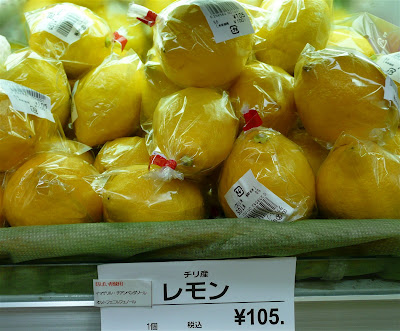Fruit is a luxury here. My eyes almost popped out of my head the first time I saw fruit in the supermarket. $30 for grapes? I later convinced myself I must have been looking at the wrong price tag, until I went back to the fruit section in the Sogo department store for a double take.
Sure enough, this is what I saw...

That's 8400 yen for a canteloupe. With 117 yen equating to 1 dollar right now, that makes this canteloupe a whopping $71.35. Well, you DO get a pretty orange bow on it after all!
I was so fascinated by the outrageous price tags that I ran around the fruit section photographing everything like a big goofball.
There was watermelon...

for $33.
A bunch of green grapes...

for $31.22.
Strawberries...

for $7.13.
And that's for a container half the size of the one back home.
Blueberries...

for $8.48 per half pint.
Gigantic peaches...

for $5.35... EACH!
Mandarin oranges...

for $53.52 per crate.
Regular oranges...

for $3.56 for two.
Apples...

for $2.67 each.
Bananas...

for $2.67 per bunch.
Grapefruit...

for $3.56 for two.
And then on the low end we've got...
Kiwi...

and lemons...

for 89 cents each.
Needless to say, we don't eat a lot of fruit here. I've been picking up grapefruit and bananas at the discount supermarket around the corner from our apartment, but that's pretty much the only fruit I ever eat. And boy do I miss it. Once in a while I do also get a chunk of pineapple at the sushi restaurant nearby for the equivalent of $1.50. Let me tell you, it is hands down the best pineapple I have ever tasted. It's good enough that at some point I'm sure I'll gladly part with the six bucks and change for a pineapple from the market.
So why is the fruit so expensive here? From what I gather from my scientific research (i.e. googling fruit and Japan), it appears that Japanese politicians are firmly in the back pocket of rural fruit farmers. In return for their support, the politicians promise protection from foreign competition.
Fruit is also given as a gift in Japan. And gift fruit isn't just any fruit — it's been painstakingly and lovingly coddled in every way imaginable. It sounds like they approach growing fruit the way winemakers approach growing their grapes. It's like a complex art.
According to an article published a couple years ago in the International Herald Tribune:
"In Shizuoka, west of Tokyo, melons are farmed in sophisticated green houses, complete with air-conditioners that fine-tune the temperate to optimal levels day and night. Melon vines are planted and cultivated in a soil bedding that is separated from the ground, said Tsuneo Anma, general secretary of a growers' group based in Fukuroi city that produces the "Crown" brand of melons. Producing 3.5 million melons annually, the agricultural cooperative is the biggest specialty-melon grower in Japan.
The soil separation is necessary to regulate moisture levels. "The moisture uptake by the tree roots must be optimized to promote proper amount of photosynthesis," Anma said. "If trees are planted in the ground, the roots will grow unregulated," making moisture absorption difficult to control.
Growers trim the vines so that only three melons will grow on each tree. When the baby melons grow to the size of a human fist, two are chopped off to allow the most promising one to monopolize all the nourishment from the vine. That one melon is expected to mature into the juicy, beautiful and revered $100 dollar fruit."
Supposedly it tastes a lot better than all that boring ordinary fruit. If the pineapple I've had is any indication, perhaps it really is better.
But I'll have to take their word for it. I can't imagine any canteloupe being sweeter than $71 in my pocket.
